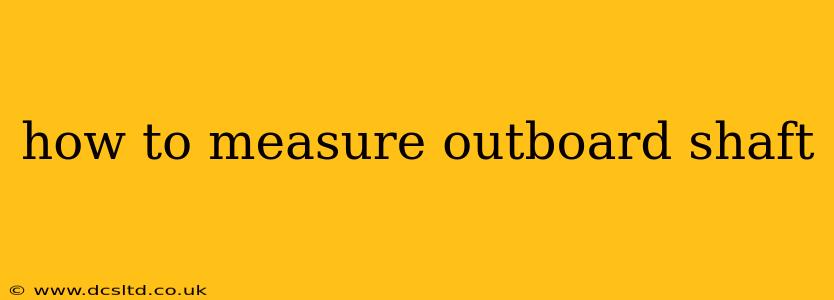Choosing the right outboard motor for your boat hinges on several factors, and one crucial aspect often overlooked is the outboard shaft length. Getting this wrong can lead to poor performance, damage to your motor, or even dangerous situations. This comprehensive guide will walk you through precisely how to measure your outboard shaft length, ensuring you make the right choice for your vessel.
Why is Outboard Shaft Length Important?
The shaft length determines how deep the propeller sits in the water. Too short, and the propeller will cavitate (lose contact with the water), reducing efficiency and potentially damaging the motor. Too long, and the propeller might hit the bottom or submerged objects, causing damage or hindering maneuverability. The correct shaft length ensures optimal performance and safety.
How to Measure Your Outboard Shaft Length: A Step-by-Step Guide
Accurately measuring your outboard shaft length is critical. Follow these steps to ensure a precise measurement:
-
Prepare Your Boat: Ensure your boat is level and sitting in the water, ideally on a calm day. A tilted or uneven boat will lead to inaccurate measurements.
-
Identify the Shaft: The outboard shaft is the long, cylindrical metal piece extending from the lower unit of the motor.
-
Locate the Measurement Point: The measurement is taken from the top of the anti-cavitation plate (the flat, horizontal plate at the bottom of the lower unit) to the top of the cavitation plate. This means you'll measure the length from the top, and not the bottom, of the cavitation plate.
-
Use a Measuring Tool: Employ a reliable measuring tape or ruler. Ensure it's long enough to reach the full length of the shaft.
-
Take the Measurement: Extend the measuring tape from the top of the anti-cavitation plate to the top of the transom. Record the measurement carefully. Be mindful of maintaining a straight line to avoid inaccuracies.
-
Double-Check Your Measurement: Repeat the measurement a couple of times to ensure accuracy and consistency.
Understanding Outboard Shaft Length Designations
Outboard shaft lengths are typically expressed in inches (e.g., 15", 20", 25"). These measurements represent the distance described in the previous section. You'll often find these measurements referenced in boat manuals and outboard motor specifications.
What if I Don't Know My Current Outboard Shaft Length?
If you're unsure about your current outboard's shaft length, you can typically find this information:
- On the Outboard Motor Itself: Check the motor's identification plate, which usually provides the shaft length.
- In Your Boat's Manual: The manual might specify the recommended or installed shaft length.
- By Contacting a Marine Mechanic or Dealer: They can identify the shaft length based on the model and serial number of your motor.
How to Choose the Right Shaft Length for a New Outboard Motor?
Choosing the correct shaft length for a new outboard motor is crucial. Several factors influence this decision:
- Boat Hull Type: Different hull designs require different shaft lengths. Consult your boat's specifications or a marine professional for guidance.
- Transom Height: The transom height (the back of your boat) directly affects shaft length. Taller transoms require longer shafts.
- Intended Use: The intended use of the boat (fishing, cruising, etc.) can influence the optimal shaft length.
Never attempt to guess the shaft length. Incorrect sizing can lead to significant damage or endangerment.
Frequently Asked Questions (FAQs)
What happens if my outboard shaft is too short?
If the shaft is too short, the propeller will likely cavitate, especially at higher speeds. This results in reduced efficiency, loss of power, and potential damage to the motor due to excessive strain.
What happens if my outboard shaft is too long?
A shaft that's too long risks hitting submerged objects or the bottom, potentially causing damage to the propeller or lower unit. It might also lead to reduced maneuverability.
Can I change the shaft length on my outboard motor?
Changing the shaft length of an outboard motor is a complex and specialized procedure that should only be performed by qualified marine mechanics. It's not a DIY project.
Where can I find replacement outboard shafts?
Replacement outboard shafts are available from marine parts suppliers and authorized dealers. However, replacing a shaft is a job for experienced technicians.
By carefully following the steps outlined in this guide, you can accurately measure your outboard shaft length and ensure your boating experience is safe and efficient. Remember, if you are unsure, always consult a qualified marine mechanic.
